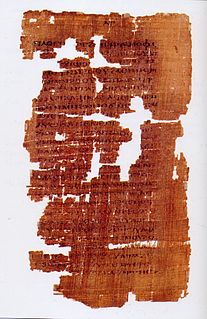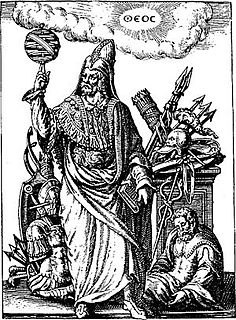Related Research Articles

The Bible is a collection of religious texts, writings, or scriptures sacred in Judaism, Samaritanism, Christianity, Islam, Rastafarianism, and many other faiths. It appears in the form of an anthology, a compilation of texts of a variety of forms that are all linked by the belief that they are collectively revelations of God. These texts include theologically-focused historical accounts, hymns, prayers, proverbs, parables, didactic letters, admonitions, essays, poetry, and prophecies. Believers also generally consider the Bible to be a product of divine inspiration.

The Epistle to the Laodiceans is a lost letter of Paul the Apostle, the original existence of which is inferred from an instruction to the congregation in Colossae to send their letter to the believing community in Laodicea, and likewise obtain a copy of the letter "from Laodicea".
And when this letter has been read to you, see that it is also read before the church at Laodicea, and that you yourselves read the letter which will be forwarded from there.
Sextus Julius Africanus was a Christian traveler and historian of the late second and early third centuries. He is important chiefly because of his influence on Eusebius, on all the later writers of Church history among the Church Fathers, and on the whole Greek school of chroniclers.

Torah has a range of meanings. It can most specifically mean the first five books of the Hebrew Bible, namely Genesis, Exodus, Leviticus, Numbers and Deuteronomy. This is known in the Jewish tradition as the Written Torah.

Hermeticism, or Hermetism, is a label used to designate a philosophical system that is primarily based on the purported teachings of Hermes Trismegistus. These teachings are contained in the various writings attributed to Hermes, which were produced over a period spanning many centuries, and may be very different in content and scope.

Menkaure, was an ancient Egyptian king (pharaoh) of the fourth dynasty during the Old Kingdom, who is well known under his Hellenized names Mykerinos and Menkheres. According to Manetho, he was the throne successor of king Bikheris, but according to archaeological evidence he was rather the successor of king Khafre. Africanus reports as rulers of the fourth dynasty Sôris, Suphis I, Suphis II, Mencherês, Ratoisês, Bicheris, Sebercherês, and Thamphthis in this order. Menkaure became famous for his tomb, the Pyramid of Menkaure, at Giza and his beautiful statue triads, showing the king together with his wives Rekhetre and Khamerernebty and with various deities.

Menes was a pharaoh of the Early Dynastic Period of ancient Egypt credited by classical tradition with having united Upper and Lower Egypt and as the founder of the First Dynasty.
Mark William Hofmann is an American counterfeiter, forger, and convicted murderer. Widely regarded as one of the most accomplished forgers in history, Hofmann is especially noted for his creation of documents related to the history of the Latter Day Saint movement. When his schemes began to unravel, he constructed bombs to murder three people in Salt Lake City, Utah. The first two bombs killed two people on October 15, 1985. On the following day, a third bomb exploded in Hofmann's car.
George Syncellus was a Byzantine chronicler and ecclesiastic. He had lived many years in Palestine as a monk, before coming to Constantinople, where he was appointed synkellos to Tarasius, patriarch of Constantinople. He later retired to a monastery to write what was intended to be his great work, a chronicle of world history, Ekloge chronographias, or Extract of Chronography. According to Anastasius Bibliothecarius, George "struggled valiantly against heresy [i.e. Iconoclasm] and received many punishments from the rulers who raged against the rites of the Church", although the accuracy of the claim is suspect.
Mizraim is the Hebrew and Aramaic name for the land of Egypt, with the dual suffix -āyim, perhaps referring to the "two Egypts": Upper Egypt and Lower Egypt. Mizraim is the dual form of matzor, meaning a "mound" or "fortress," the name of a people descended from Ham. It was the name generally given by the Hebrews to the land of Egypt and its people.

Pseudepigrapha are falsely attributed works, texts whose claimed author is not the true author, or a work whose real author attributed it to a figure of the past.

Manetho is believed to have been an Egyptian priest from Sebennytos who lived in the Ptolemaic Kingdom in the early third century BC, during the Hellenistic period. He authored the Aegyptiaca in Greek, a major chronological source for the reigns of the kings of ancient Egypt. It is unclear if he wrote his history and king list during the reign of Ptolemy I Soter or Ptolemy II Philadelphos, but it was completed no later than that of Ptolemy III Euergetes.
Berossus was a Hellenistic-era Babylonian writer, a priest of Bel Marduk and astronomer who wrote in the Koine Greek language, and who was active at the beginning of the 3rd century BC. Versions of two excerpts of his writings survive, at several removes from the original.

Joseph and Aseneth is a narrative that dates from between 200 BCE and 200 CE. The first part of the story, an expansion of Genesis 41:45, describes the diffident relationship between Aseneth, the daughter of an Egyptian priest of Heliopolis and the Hebrew patriarch Joseph, the vision of Aseneth in which she is fed honeycomb by a heavenly being, her subsequent conversion to the God of Joseph, followed by romance, marriage, and the birth of Manasseh and Ephraim. The second part involves a plot by the Pharaoh's son, who recruits Dan and Gad to kill Joseph, only to be thwarted by Benjamin and Levi.
Osarseph or Osarsiph is a legendary figure of Ancient Egypt who has been equated with Moses. His story was recounted by the Ptolemaic Egyptian historian Manetho in his Aegyptiaca ; Manetho's work is lost, but the 1st century AD Jewish historian Josephus quotes extensively from it.
The Apostolic Tradition is an early Christian treatise which belongs to the genre of the Church Orders. It has been described to be of "incomparable importance as a source of information about church life and liturgy in the third century".
The Huahujing is a Taoist work, traditionally attributed to Laozi.

The Protocols of the Elders of Zion or The Protocols of the Meetings of the Learned Elders of Zion is a fabricated antisemitic text purporting to describe a Jewish plan for global domination. The hoax was shown to be plagiarized from several earlier sources, some not antisemitic in nature. It was first published in Russia in 1903, translated into multiple languages, and disseminated internationally in the early part of the 20th century.
The Seventh Dynasty of Egypt would mark the beginning of the First Intermediate Period in the early 22nd century BC but its actual existence is debated. The only historical account on the Seventh Dynasty was in Manetho's Aegyptiaca, a history of Egypt written in the 3rd century BC, where the Seventh Dynasty appears essentially as a metaphor for chaos. Since next to nothing is known of this dynasty beyond Manetho's account, Egyptologists such as Jürgen von Beckerath and Toby Wilkinson have usually considered it to be fictitious. In a 2015 re-appraisal of the fall of the Old Kingdom, the Egyptologist Hracht Papazian has proposed that the Seventh Dynasty was real and that it consisted of kings usually attributed to the Eighth Dynasty.

The Gospel of Jesus' Wife is a papyrus fragment with Coptic text that includes the words, "Jesus said to them, 'my wife...'". The text received widespread attention when first publicized in 2012 for the implication that some early Christians believed that Jesus was married.
References
- ↑ Ecloga Chronographica 73.14
- 1 2 Gerald Verbrugghe; John Wickersham (19 January 2001). Berossos and Manetho, Introduced and Translated: Native Traditions in Ancient Mesopotamia and Egypt. University of Michigan Press. pp. 177–. ISBN 978-0-472-08687-0 . Retrieved 16 October 2012.
- ↑ Adler, W., Berossus, Manetho, and 1 Enoch in the World Chronicle of Panodorus, The Harvard Theological Review, 1983 - Cambridge Univ Press.